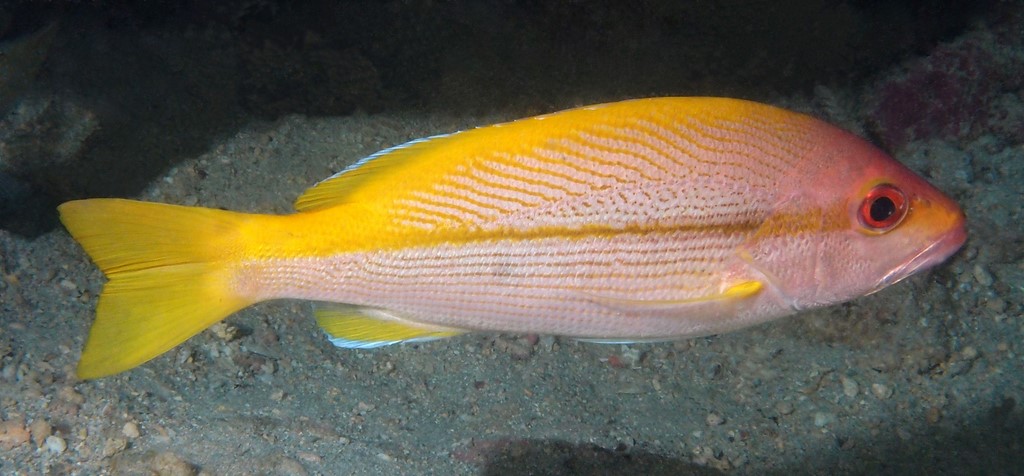LUTJANUS VITTA - (QUOY & GAIMARD, 1824)
Actinopterygii (Gigaclass) > Actinopteri (Class) > Teleostei (Subclass) > Acanthuriformes (Order) > Lutjanidae (Family) > Lutjaninae (Subfamily) > Lutjanus (Genus)
Vivaneau à bande brune, Vivaneau à bandes noires, Jaunet, Broadband seaperch, Brown stripped snapper, Brownstripe red snapper, Brownstripe seaperch, Brownstripe snapper, Pargo bitilla, Pargo de bandas castanhas, Brunstribet snapper, Yokosuji-fuedai, タテフエダイ, عصموديّ ذورُقعة بُنِّية, 동갈퉁돔, 赤笔仔, 畫眉笛鯛, 画眉笛鲷, ปลากะพงเหลืองขมิ้น, ปลาข้างแถว,
Synonymes
Lutianus vitta (Quoy & Gaimard, 1824)
Lutjanus iita (Quoy & Gaimard, 1824)
Lutjanus vita (Quoy & Gaimard, 1824)
Lutjanus vittus (Quoy & Gaimard, 1824)
Mesoprion enneacanthus (Bleeker, 1849)
Mesoprion phaiotaeniatus (Bleeker, 1849)
Serranus vitta (Quoy & Gaimard, 1824)
----------------------
Description
Dorsal spines (total): 10; Dorsal soft rays (total): 12-14; Anal spines: 3; Anal soft rays: 8-9; Pectoral fin rays: 15-16; Lateral line scales: 49-51; Gill rakers: 6-7 + 9-12; Body depth: 2.6-3.0 in SL. Body moderately deep to relatively slender. Preorbital width about equal to eye diameter; preopercular notch and knob poorly developed. Posterior profile of dorsal and anal fins angular. Scale rows on back rising obliquely above lateral line. Caudal fin truncate or slightly emarginate. Max. length: 40.0 cm TL, common length: 35.0 cm TL. Max. reported age: 12 years. Depth range: 10 - 106 m.
Color
Juveniles and sub-adults have a broader, darker stripe than adults.
A whitish to pinkish tropical snapper with a yellowish-brown to black mid-lateral stripe, fine diagonal stripes above the lateral line and narrow horizontal brown stripes below the lateral line, and a yellow back and median fins.
Etymology
Lutjanus: from Malay, ikan lutjan, name of a fish.
vitta: from Latin, vieō = band, ribbon. Referring to dark-brown to black stripe along middle of side from posterior edge of eye to upper half of caudal peduncle.
Original description: Serranus vitta Quoy & Gaimard, 1824 - Type locality: Waigeo, island in West Papua province of eastern Indonesia.
Distribution
Indo-West Pacific: Seychelles; India, Sri Lanka, Bangladesh and Myanmar, east to Marshall Islands and New Ireland (Papua New Guinea), north to Ryukyu Islands (Japan), south to northern Australia and New Caledonia.
Biology
Adults are found in the vicinity of coral reefs, also areas with flat bottoms and occasional low coral outcrops, sponges, and sea whips. They occur singly or in groups of up to about 30 individuals. Feed on fishes, shrimps, crabs and other benthic invertebrates. Sex ratio differed significantly from 1:1 above 30 cm fork length. Larvae grow at a rate of 1.2-1.7 mm per day during the first 1 or 2 months. Commercially important throughout its range, and taken by commercial fishers in Australia.
Similar species
Lutjanus adetii (Castelnau, 1873) - Reported from New Caledonia - Link to the species (here).
Vivaneau à bande brune, Vivaneau à bandes noires, Jaunet, Broadband seaperch, Brown stripped snapper, Brownstripe red snapper, Brownstripe seaperch, Brownstripe snapper, Pargo bitilla, Pargo de bandas castanhas, Brunstribet snapper, Yokosuji-fuedai, タテフエダイ, عصموديّ ذورُقعة بُنِّية, 동갈퉁돔, 赤笔仔, 畫眉笛鯛, 画眉笛鲷, ปลากะพงเหลืองขมิ้น, ปลาข้างแถว,
Synonymes
Lutianus vitta (Quoy & Gaimard, 1824)
Lutjanus iita (Quoy & Gaimard, 1824)
Lutjanus vita (Quoy & Gaimard, 1824)
Lutjanus vittus (Quoy & Gaimard, 1824)
Mesoprion enneacanthus (Bleeker, 1849)
Mesoprion phaiotaeniatus (Bleeker, 1849)
Serranus vitta (Quoy & Gaimard, 1824)
----------------------
Description
Dorsal spines (total): 10; Dorsal soft rays (total): 12-14; Anal spines: 3; Anal soft rays: 8-9; Pectoral fin rays: 15-16; Lateral line scales: 49-51; Gill rakers: 6-7 + 9-12; Body depth: 2.6-3.0 in SL. Body moderately deep to relatively slender. Preorbital width about equal to eye diameter; preopercular notch and knob poorly developed. Posterior profile of dorsal and anal fins angular. Scale rows on back rising obliquely above lateral line. Caudal fin truncate or slightly emarginate. Max. length: 40.0 cm TL, common length: 35.0 cm TL. Max. reported age: 12 years. Depth range: 10 - 106 m.
Color
Juveniles and sub-adults have a broader, darker stripe than adults.
A whitish to pinkish tropical snapper with a yellowish-brown to black mid-lateral stripe, fine diagonal stripes above the lateral line and narrow horizontal brown stripes below the lateral line, and a yellow back and median fins.
Etymology
Lutjanus: from Malay, ikan lutjan, name of a fish.
vitta: from Latin, vieō = band, ribbon. Referring to dark-brown to black stripe along middle of side from posterior edge of eye to upper half of caudal peduncle.
Original description: Serranus vitta Quoy & Gaimard, 1824 - Type locality: Waigeo, island in West Papua province of eastern Indonesia.
Distribution
Indo-West Pacific: Seychelles; India, Sri Lanka, Bangladesh and Myanmar, east to Marshall Islands and New Ireland (Papua New Guinea), north to Ryukyu Islands (Japan), south to northern Australia and New Caledonia.
Biology
Adults are found in the vicinity of coral reefs, also areas with flat bottoms and occasional low coral outcrops, sponges, and sea whips. They occur singly or in groups of up to about 30 individuals. Feed on fishes, shrimps, crabs and other benthic invertebrates. Sex ratio differed significantly from 1:1 above 30 cm fork length. Larvae grow at a rate of 1.2-1.7 mm per day during the first 1 or 2 months. Commercially important throughout its range, and taken by commercial fishers in Australia.
Similar species
Lutjanus adetii (Castelnau, 1873) - Reported from New Caledonia - Link to the species (here).
Lutjanus lutjanus (Bloch, 1790) - Reported from New Caledonia.
Lutjanus ophuysenii (Bleeker, 1860) - Reported from Western Pacific: southern China and Taiwan north to Korea and Japan.
Lutjanus ophuysenii (Bleeker, 1860) - Reported from Western Pacific: southern China and Taiwan north to Korea and Japan.
Last update: 26, March 2023
